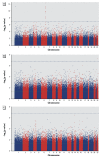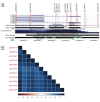Epigenome-Wide Assessment of DNA Methylation in the Placenta and Arsenic Exposure in the New Hampshire Birth Cohort Study (USA)
- PMID: 26771251
- PMCID: PMC4977055
- DOI: 10.1289/ehp.1510437
Epigenome-Wide Assessment of DNA Methylation in the Placenta and Arsenic Exposure in the New Hampshire Birth Cohort Study (USA)
Abstract
Background: Arsenic is one of the most commonly encountered environmental toxicants, and research from model systems has suggested that one mode of its toxic activity may be through alterations in DNA methylation. In utero exposure to arsenic can affect fetal, newborn, and infant health, resulting in a range of phenotypic outcomes.
Objectives: This study examined variation in placental DNA methylation and its relationship to arsenic exposure in 343 individuals enrolled in the New Hampshire Birth Cohort Study.
Methods: Linear regression models using a reference-free correction to account for cellular composition were employed to determine CpG loci affected by arsenic levels.
Results: Total arsenic measured in maternal urine during the second trimester was not associated with methylation in the placenta, whereas arsenic levels quantified through maternal toenail collected at birth were associated with methylation at a single CpG locus (p = 4.1 × 10-8). Placenta arsenic levels were associated with 163 differentially methylated loci (false discovery rate < 0.05), with 11 probes within the LYRM2 gene reaching genome-wide significance (p < 10-8). Measurement of LYRM2 mRNA levels indicated that methylation was weakly to moderately correlated with expression (r = 0.15, p < 0.06). In addition, we identified pathways suggesting changes in placental cell subpopulation proportions associated with arsenic exposure.
Conclusions: These data demonstrate the potential for arsenic, even at levels commonly experienced in a U.S. population, to have effects on the DNA methylation status of specific genes in the placenta and thus supports a potentially novel mechanism for arsenic to affect long-term children's health.
Citation: Green BB, Karagas MR, Punshon T, Jackson BP, Robbins DJ, Houseman EA, Marsit CJ. 2016. Epigenome-wide assessment of DNA methylation in the placenta and arsenic exposure in the New Hampshire Birth Cohort Study (USA). Environ Health Perspect 124:1253-1260; http://dx.doi.org/10.1289/ehp.1510437.
Conflict of interest statement
The contents of this paper are solely the responsibility of the grantee and do not necessarily represent the official views of the U.S. EPA. Further, the U.S. EPA does not endorse the purchase of any commercial products or services mentioned in the presentation.
The authors declare they have no actual or potential competing financial interests.
Figures




Comment in
-
Arsenic and the Placental Epigenome: Unlocking the Secrets of Prenatal Exposure.Environ Health Perspect. 2016 Aug 1;124(8):A148. doi: 10.1289/ehp.124-A148. Environ Health Perspect. 2016. PMID: 27479242 Free PMC article. No abstract available.
Similar articles
-
Cadmium-Associated Differential Methylation throughout the Placental Genome: Epigenome-Wide Association Study of Two U.S. Birth Cohorts.Environ Health Perspect. 2018 Jan 22;126(1):017010. doi: 10.1289/EHP2192. Environ Health Perspect. 2018. PMID: 29373860 Free PMC article.
-
In utero arsenic exposure and epigenome-wide associations in placenta, umbilical artery, and human umbilical vein endothelial cells.Epigenetics. 2015;10(11):1054-63. doi: 10.1080/15592294.2015.1105424. Epigenetics. 2015. PMID: 26646901 Free PMC article.
-
Differential DNA methylation in umbilical cord blood of infants exposed to low levels of arsenic in utero.Environ Health Perspect. 2013 Aug;121(8):971-7. doi: 10.1289/ehp.1205925. Epub 2013 Jun 11. Environ Health Perspect. 2013. PMID: 23757598 Free PMC article.
-
Arsenic and the placenta: A review with emphasis on the immune system.Placenta. 2025 Feb;160:73-81. doi: 10.1016/j.placenta.2024.12.019. Epub 2024 Dec 24. Placenta. 2025. PMID: 39778256 Review.
-
Human placental methylome in the interplay of adverse placental health, environmental exposure, and pregnancy outcome.PLoS Genet. 2019 Aug 1;15(8):e1008236. doi: 10.1371/journal.pgen.1008236. eCollection 2019 Aug. PLoS Genet. 2019. PMID: 31369552 Free PMC article. Review.
Cited by
-
Arsenic and the Placental Epigenome: Unlocking the Secrets of Prenatal Exposure.Environ Health Perspect. 2016 Aug 1;124(8):A148. doi: 10.1289/ehp.124-A148. Environ Health Perspect. 2016. PMID: 27479242 Free PMC article. No abstract available.
-
Lasting Impact of an Ephemeral Organ: The Role of the Placenta in Fetal Programming.Environ Health Perspect. 2016 Jul 1;124(7):A124-9. doi: 10.1289/ehp.124-A124. Environ Health Perspect. 2016. PMID: 27479992 Free PMC article. No abstract available.
-
'Omics in environmental epidemiological studies of chemical exposures: A systematic evidence map.Environ Int. 2022 Jun;164:107243. doi: 10.1016/j.envint.2022.107243. Epub 2022 Apr 12. Environ Int. 2022. PMID: 35551006 Free PMC article.
-
Inter- and Transgenerational Effects of Paternal Exposure to Inorganic Arsenic.Adv Sci (Weinh). 2021 Feb 18;8(7):2002715. doi: 10.1002/advs.202002715. eCollection 2021 Apr. Adv Sci (Weinh). 2021. PMID: 33854880 Free PMC article.
-
Acetaminophen use during pregnancy and DNA methylation in the placenta of the extremely low gestational age newborn (ELGAN) cohort.Environ Epigenet. 2019 Aug 6;5(2):dvz010. doi: 10.1093/eep/dvz010. eCollection 2019 Apr. Environ Epigenet. 2019. PMID: 31404209 Free PMC article.
References
-
- Bouché N, Scharlat A, Snedden W, Bouchez D, Fromm H. A novel family of calmodulin-binding transcription activators in multicellular organisms. J Biol Chem. 2002;277:21851–21861. - PubMed
Publication types
MeSH terms
Substances
Grants and funding
LinkOut - more resources
Full Text Sources
Other Literature Sources
Medical
Molecular Biology Databases

